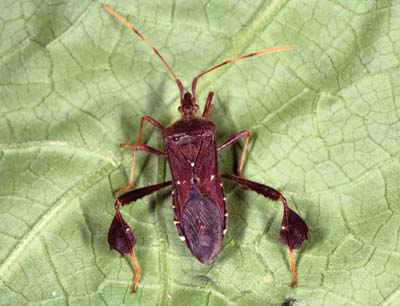To save the Web-optimized images shown below to your hard drive:
|
Click to access Display and Print quality images. |
Leaf-footed bugs are widespread and conspicuous minor pests of many crops. Serious infestations do not normally occur, but a large portion of the crop may be lost where they are numerous. Adults may feed on opening buds, tender shoots, or fruits. Fruit drop may occur if high populations of leaf-footed bugs are present. Vegetable crops that are sometimes heavily infested include potato, tomato, sunflower, bean, cowpea, eggplant, bell pepper, okra, and cucurbits. Leaf-footed bugs are usually controlled by the application of insecticides, cultural practices, and by hand picking in small plots or garden situations.
Images
To save the Web-optimized images shown below to your hard drive:

A leaf-footed bug, Leptoglossus oppositus, adult.
(Photographer: L. Buss, University of Florida)
Click to access Display and Print quality images.
|
Click to access Display and Print quality images. |
|
Click to access Display and Print quality images. |